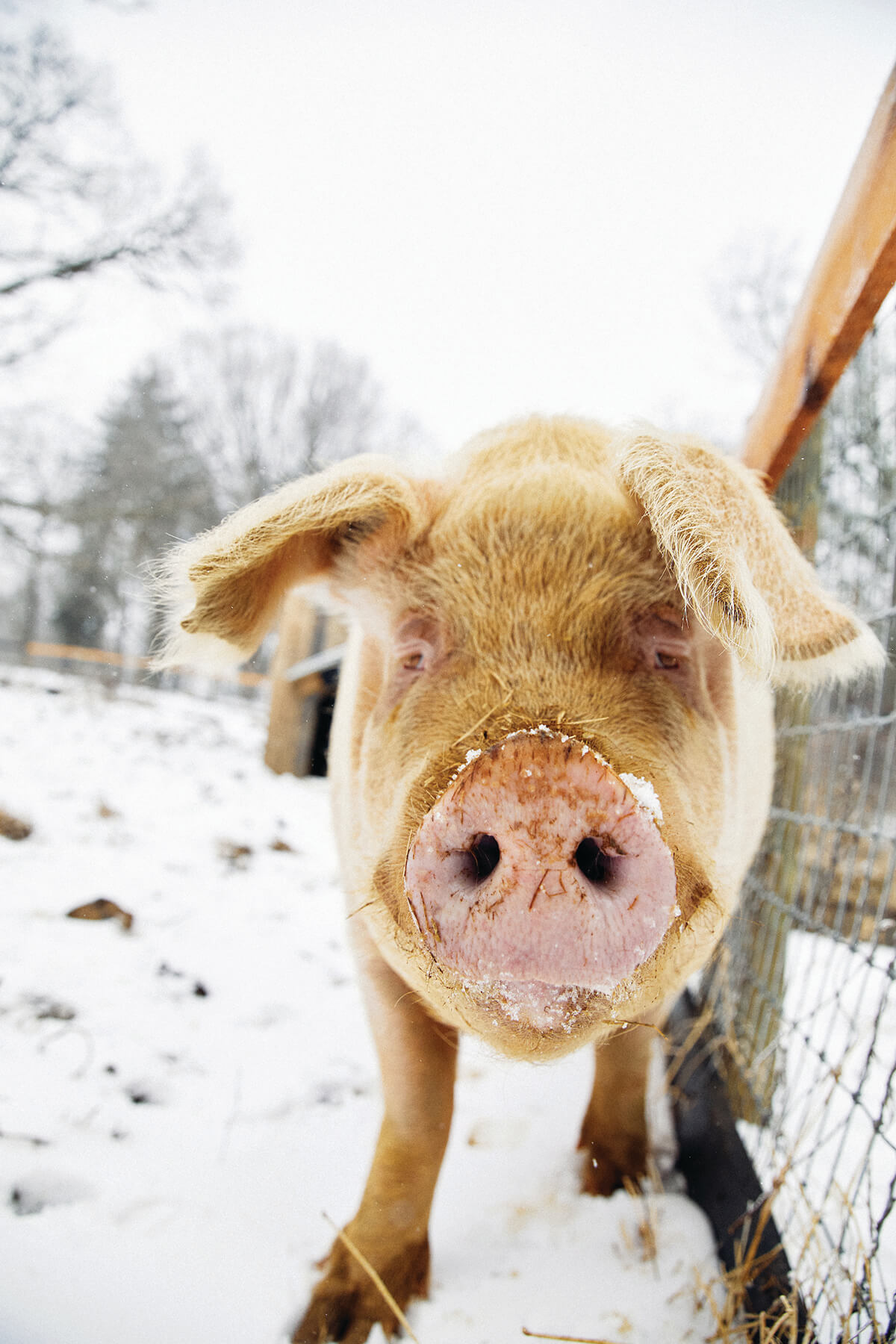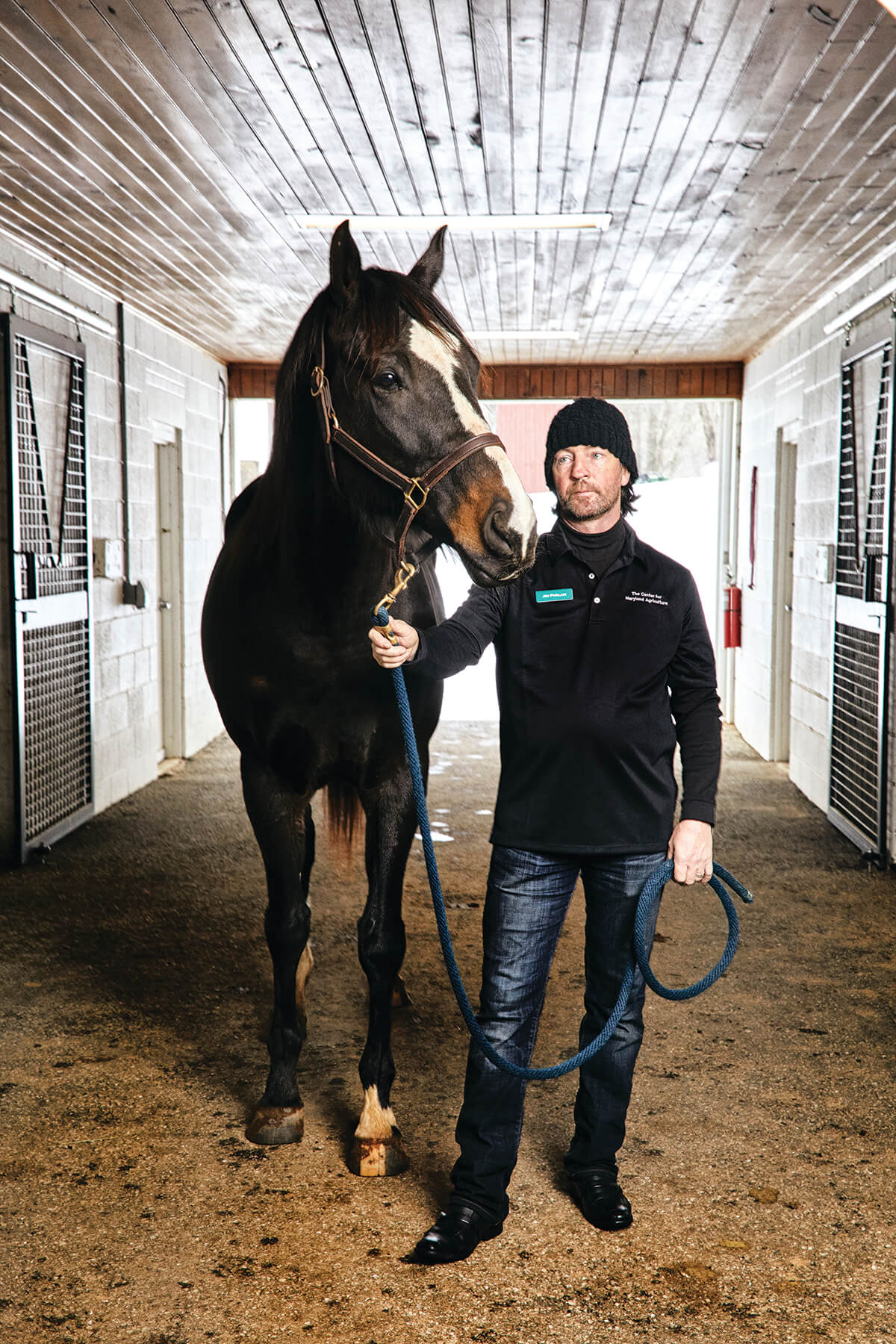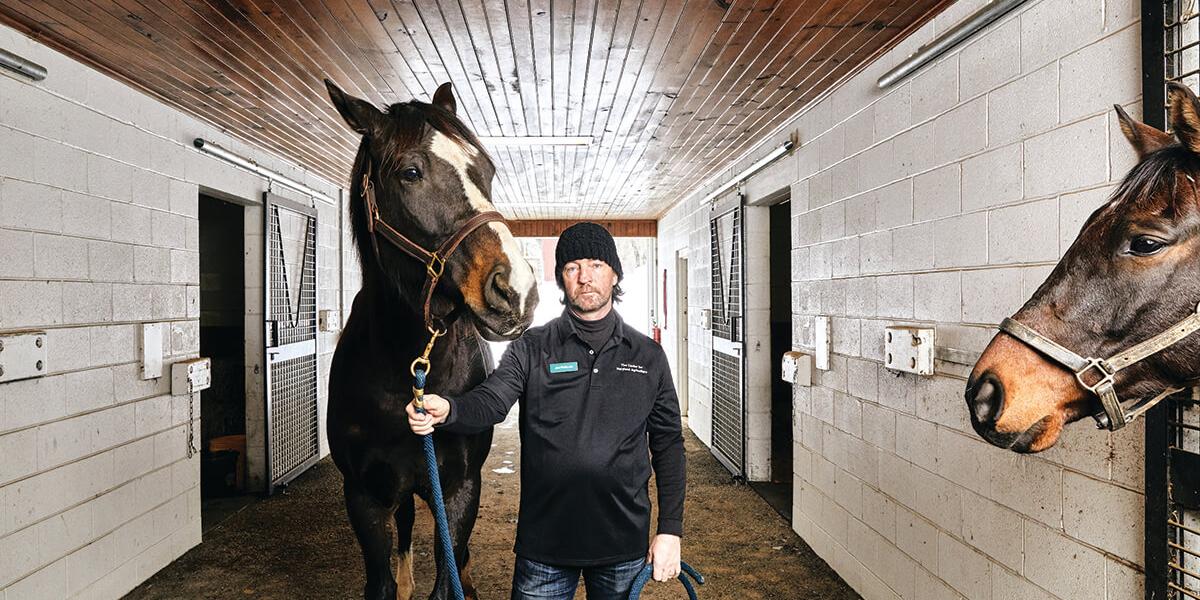Travel & Outdoors
Animal Farm
The Baltimore County Center for Maryland Agriculture is a largely unknown oasis on the edge of the city.
He speaks with an Irish accent: “Let me get the little one for ya.” And the man we just met, wearing a white T-shirt, blue jeans, and sporting dark scruff, hops over a wooden fence into the wispy tall grass of the pasture, then glances down where his feet landed. He sees something glinting in the sun, a set of horse blinders and a bug net used to keep critters out of horses’ faces.
“I’ve been looking for those,” he says. “I spent 30 minutes this morning trying to find them.” He deftly picks the items up and places them in his pants pocket.
It’s a warm, late summer afternoon, and I’m holding my 1-year-old daughter, Molly, in my arms as we stand atop a hill, surrounded by farmland, at the Baltimore County Center for Maryland Agriculture. My wife, Jamie, stands next to me with the stroller, and the sturdy Irishman, who later introduces himself as Jim, is off in a nearby field fetching a horse to show our baby. In the distance, four horses, two big and two small ones, are grazing, and when Jim gets about 40 yards away, he whistles to get the smallest’s attention, coaxing the white pony toward us, like he’s walking a dog off leash.
“You’re like the horse whisperer,” Jamie yells to Jim as he gets closer. To me, he looks more like Ray Liotta as “Shoeless” Joe Jackson exiting the cornfields in the famed baseball movie Field of Dreams, with horses in tow instead of the 1919 Chicago Black Sox. The remaining horses, two of them large brown and white thoroughbreds, follow the little one, their tails swooshing with curiosity. “They think I have food,” Jim says with a chuckle.
Molly is doing her amused, curious pointing thing at the biggest one, when Jim tells us about where they came from and what they’re doing here. One, named Tina, is an old racehorse rescued from a kill pen in Pennsylvania. The other big one is a laidback 31-year-old named Doc, who injured a back leg about 18 years ago and was donated by River Valley Ranch, a nonprofit ministry in Manchester, Maryland. Today, they’re used as therapy horses for kids and adults.
As Jim speaks, we look around and see endless forest and clear skies to the north and west, Timonium office buildings to the east across the valley of Interstate 83, and the tops of buildings in Towson to the south. It quickly becomes clear we’re standing on a hidden gem of a property, an oasis on the edge of the city, a place that makes us think, “How did we not know this was here before?”
I start taking notes on my phone. “You’re a writer?” Jim says. “You should write a feature about this place. We’re trying to get the word out.”
I couldn’t agree more.
Of course, Baltimore and the entire state of Maryland has a deep and rich equestrian history. The Preakness has been run in the city for well over a century, and a quick drive from downtown will take you past fields of horse farms soon enough, but the proximity and accessibility of this particular farm—it’s also a county park—with its old racehorses grazing for public view minutes from our own home, took us by surprise.
At 149 acres, the place is roughly the size of 113 football fields in the beautiful Maryland countryside, which Jim says reminds him of the Irish hills in which he was born, and it’s open to the public every day of the year. It’s also much closer and cheaper than a trip to Ireland.
It’s a well-traveled area of Baltimore County—you’ve likely driven past it on your way to the Hunt Valley Mall or Oregon Ridge Nature Center—but we’re not the only ones who have passed the brown, county-styled Agriculture Center sign near the road without thinking twice.
“I think people drive by and think we’re a private business or something,” says Gina Porter, the farm’s manager, who was hired in July. “I want people to know that this is a county park for them paid for by their tax dollars. And we’re open sunrise to sunset every day.”
We had come across the Agriculture Center on the recommendation of a good friend who suggested it as a way to break the pandemic-fueled monotony of endless walks around our neighborhood. (As new parents, we were desperately looking for a socially distanced place to wander around outside between Molly’s naps.) We had never even heard of the place, but our friend told us it was near Oregon Ridge Park, and there were goats. That was about all the incentive we needed.
The day we were there, there couldn’t have been more than a half-dozen people on the property, but fortunately one of them was Jim. After a picnic lunch in the shade of a row of starting-to-turn-fall-color trees, we spotted him leaning against a metal fencepost within eyeshot of the parking lot and what looked like a barn behind him.
“Are we allowed to walk around here?” my wife asked tentatively. “Well, you’re not going to get arrested,” he said. Then he pointed us to a steep hill, over to the right where the horses were roaming today.
His full name is Jim Phelan, and he’s a 48-year-old former jockey (taller than you might think) who was essentially born into the horse industry in Ireland and rode professionally for three decades during a globetrotting career in Ireland, Japan, Saudi Arabia, Australia, and Dubai. He moved to Baltimore 15 years ago to work as an exercise rider to keep the horses in shape at Pimlico Race Course and Laurel Park.
He’s an obviously approachable guy, and that was before we learned he’s also the lead singer and banjo player in the Irish band The ShamRogues, a group he started in 2009. His wife, Katie, a Baltimore-born Irish dancer, is in the band, too. When we ask him what he does at the Agriculture Center, where he’s worked since 2018, he shows some of the charm befitting a frontman and modestly calls himself a “gofer.” His official title is Farm and Livestock Specialist. Along with another staffer and two interns, he tends to and feeds the horses, sheep, goats, pigs, and chickens on the property.
“I WANT PEOPLE TO KNOW THIS A COUNTY PARK PAID FOR BY THEIR TAX DOLLARS.”
As we chat upon the hill next to a run-down, long white barn that looks like it likely dates well before the turn of the last century, when this land was privately-owned, Phelan starts telling us exactly what goes on here. Yes, you can pull up the driveway, lined by beautiful trees on both sides, park, and simply spend a few good hours wandering the grounds, or you can take part in more deliberate activities like farming or gardening classes.
The first building you’ll see is the welcome center. Admittedly, it does look more like a corporate headquarters than a place for visitors, and it kind of is, as it doubles as an office for several farming agencies, like the U.S. Department of Agriculture, and used to serve as a voting location in election years. It was originally conceived as a one-stop shop for local farmers to get questions answered and do business.
Now it almost feels like a one-stop shop for anyone interested in the outdoors. For a family, you can simply sit outside and have a picnic in a quiet landscape while watching the black and white sheep and goats. For the sustainable-minded looking to grow their own food, there’s an upcoming program for that, too. This spring, says Porter, a University of Maryland graduate who grows her own food at home, the county will start providing some of the Agriculture Center’s farmland to beginning farmers who are interested in a low-cost and low-risk way of getting started.
In a greenhouse near the welcome center, there is already space for rent, “similar to a community garden,” Porter says, where volunteer farmers and county staff have grown organic food that’s donated to the Maryland Food Bank. The American Chestnut Foundation is breeding disease-resistant trees in there, too, to try to help bring back the species from the brink of extinction.
If you’re looking to exercise, there are challenging hiking trails, and off-road bike riders are welcome, one of the few county parks where that is the case. And, broadly speaking, the land is a sanctuary for animals, like the horses and four rescued pigs in two separate pens. Two fell off a truck on I-695, saving them from being bacon, and the other two were found abandoned in a landfill. (We fed those two potbellies a few extra carrots and strawberries left over from our picnic lunch.)
And the horses, whether they know it or not, are paying their rescues forward to kids and adults who visit them. Doc, for instance—he’s one of the horses we saw, the calm-tempered 31-year-old—is part of the Eagala organization, which uses horses in open-air, equine therapy sessions for children dealing with anxiety, depression, or other disorders.
In certain situations, having a sensitive, non-judgmental animal like a horse present can help kids open up to a therapist. Separately, the farm has welcomed schoolkids and foster children from the city and surrounding areas for field trips that expose them to a new environment.


But perhaps the center’s most signature program is its partnership with Saratoga WarHorse, a New York-based nonprofit with a chapter in Baltimore. Founded in 2012 by decorated Vietnam War veteran Bob Nevins, it brings together rescued former racehorses and war veterans, active-duty military, and recently, frontline workers facing COVID-19—who are struggling with conditions like post-traumatic stress—for free, hands-on therapeutic sessions.
Roughly every other Friday, in one of the Agriculture Center’s indoor or outdoor arenas, or pens, Phelan hands a half-dozen naturally skittish horses over to trainer Suzanne Berger and a class of five or six participants for private, confidential sessions over the course of three days.
The abiding philosophy of the program is this: The horses that have been saved and the humans looking for relief have more in common than you may imagine.
Take Tina, who ran two races in her career and finished last both times. After her offspring were equally unsuccessful racing, “she kind of got lost along the way,” Phelan says, and was ultimately saved by a former owner who learned she was bound for slaughter in Mexico.
“They were going to be decommissioned,” says Marc Junkerman, a police lieutenant, Army veteran, and graduate of the WarHorse program, putting the horses’ often near-death post-racing condition in end-of-duty military terms. “They weren’t going to stud.”
THE MEETING BETWEEN HORSE AND HUMAN IS DESIGNED TO BUILD TRUST ON BOTH SIDES.
When Junkerman went through the program two years ago, he was dealing with a separation from his wife, caregiving for his father who was going through cancer, stresses from work, and was in a bad place, just like the horses once were.
The meeting between horse and human is designed to build trust on both sides. It might start with the horse running wild around the pen—and a few new realizations.
“You’re locked in a pen with a 1,200-pound thoroughbred,” Junkerman says. “I didn’t realize they were that freaking big in real life and run that fast for real.”
The session ideally commences with an especially cathartic moment, a horseman’s handshake: a gentle nuzzle from the big animal. In some cases, it culminates with a participant guiding the horses through a series of tight, reinless figure-eight walks.
Those things only happen if the horse trusts you, if you let it see you and its surroundings long enough to get comfortable, a formidable challenge. A horse is a prey animal, explains Porter, that sees two different sets of images out of each of its eyes, meaning its brain is on extra alert for predators. That’s something that veterans, also on high alert from the battlefield, know all too well and can struggle letting go of in civilian life.
“It’s a forgiveness thing,” says Porter, “that the predator—the veterans, so to speak—can gain the trust of the prey, and that allows them to release some of the trauma they have.”
Junkerman, who now volunteers for the WarHorse program, recalls his experience while sitting on a set of metal bleachers that overlook an outdoor equestrian pen. He says of the property, “This is everything community is supposed to be, where everybody can be themselves and enjoy,” adding that a few licks from a former racehorse named Dun, Dun, Dun—on loan from nearby Sagamore Farm—changed his life.
“I felt something on my hands,” he says, “and I’m like, ‘Are those horse’s lips?’ And at that point, you bond, and you don’t see or hear anything else. It’s therapeutic.”
It’s not an atypical story. “I’ve seen people come here who were suicidal and leave changed,” says Phelan, who describes some veterans leaving in tears.
As he speaks, the big rescued horses behind him, Tina and Doc, and the two smaller ponies, are slowly walking back to the center of the field, suddenly uninterested in us.
It turns out, Jim didn’t have food, and neither did we. And it’s getting close to Molly’s nap time, which means we need to leave this sanctuary behind for now.
But we promise to come back soon, to which Jim says, “Please, anytime.”
